Promoting Geoheritage in the Aspiring Geopark of Taburno-Camposauro (Southern Apennines, Italy) with Innovative Tools
Abstract
1. Introduction
2. Study Area
3. Materials and Methods
4. Geoheritage
5. Promotional Activity
5.1. Traditional Activities
5.2. Innovative Activities
6. Conclusions
Author Contributions
Funding
Data Availability Statement
Acknowledgments
Conflicts of Interest
References
- Marchetti, M.; Ghinoi, A.; Soldati, M. The Dolomite Landscape of the Alta Badia (Northeastern Alps): A Remarkable Record of Geological and Geomorphological History. In Landscapes and Landforms of Italy; Soldati, M., Marchetti, M., Eds.; Springer International Publishing: Manhatton, NY, USA, 2017; Volume 35, pp. 123–134. [Google Scholar] [CrossRef]
- Valente, A.; Magliulo, P.; Russo, F. The coastal landscape of Cilento (southern Italy): A challenge for protection and tourism valorization. In Landscapes and Landforms of Italy; Soldati, M., Marchetti, M., Eds.; Springer International Publishing: Manhatton, NY, USA, 2017; Volume 35, pp. 409–419. [Google Scholar] [CrossRef]
- Eder, W.; Patzak, M. Geoparks—Geological attractions: A tool for public education, recreation and sustainable economic development. Episodes 2004, 27, 162–164. [Google Scholar] [CrossRef] [PubMed]
- Newsome, D.; Dowling, R. Geoheritage and Geotourism. In Geoheritage: Assessment, Protection, and Management; Reynard, E., Brilha, J.B., Eds.; Elsevier: Amsterdam, The Netherlands, 2018; pp. 305–321. ISBN 9780128095317. [Google Scholar]
- Dodick, J.; Orion, N. Geology as an Historical Science: Its Perception within Science and the Education System. Sci. Educ. 2003, 12, 197–211. [Google Scholar] [CrossRef]
- Stewart, I.S.; Nield, T. Earth stories: Context and narrative in the communication of popular geosciences. Proc. Geol. Assoc. 2013, 124, 699–712. [Google Scholar] [CrossRef]
- Gray, M. Geodiversity: Valuing and Conserving Abiotic Nature; John Wiley & Sons: Chichester, UK, 2004. [Google Scholar]
- van Wyk de Vries, B.; Byrne, P.; Delcamp, A.; Einarson, P.; Göğüş, O.; Guilbaud, M.-N.; Hagos, M.; Harangi, S.; Jerram, D.; Matenco, L.; et al. A global framework for the Earth: Putting geological sciences in context. Glob. Planet Change 2018, 171, 293–321. [Google Scholar] [CrossRef]
- Perotti, L.; Bollati, I.M.; Viani, C.; Zanoletti, E.; Caironi, V.; Pelfini, M.; Giardino, M. Fieldtrips and virtual tours as geotourism resources: Examples from the Sesia Val Grande UNESCO Global Geopark (NW Italy). Resources 2020, 9, 63. [Google Scholar] [CrossRef]
- Papadopoulou, E.E.; Kasapakis, V.; Vasilakos, C.; Papakonstantinou, A.; Zouros, N.; Chroni, A.; Soulakellis, N. Geovisualization of the excavation process in the Lesvos petrified forest, Greece using augmented reality. ISPRS Int. J. Geo-Inf. 2020, 9, 374. [Google Scholar] [CrossRef]
- Marescotti, P.; Castello, G.; Briguglio, A.; Caprioglio, M.C.; Crispini, L.; Firpo, M. Geosite Assessment in the Beigua UNESCO Global Geopark (Liguria, Italy): A Case Study in Linking Geoheritage with Education, Tourism, and Community Involvement. Land 2022, 11, 1667. [Google Scholar] [CrossRef]
- Tropeano, M.; Caldara, M.A.; De Santis, V.; Festa, V.; Parise, M.; Sabato, L.; Spalluto, L.; Francescangeli, R.; Iurilli, V.; Mastronuzzi, G.A.; et al. Geological Uniqueness and Potential Geotouristic Appeal of Murge and Premurge, the First Territory in Puglia (Southern Italy) Aspiring to Become a UNESCO Global Geopark. Geosciences 2023, 13, 131. [Google Scholar] [CrossRef]
- Pralong, J.P. A method for assessing tourist potential and use of geomorphological sites. Géomorphol. Relief Process. Environ. 2005, 11, 189–196. [Google Scholar] [CrossRef]
- Ruban, D.A. Representation of geologic time in the global geopark network: A web-page study. Tour. Manag. Perspect. 2016, 20, 204–208. [Google Scholar] [CrossRef]
- Wolniewicz, P. Bringing the History of the Earth to the Public by Using Storytelling and Fossils from Decorative Stones of the City of Poznań, Poland. Geoheritage 2019, 11, 1827–1837. [Google Scholar] [CrossRef]
- Doyle, E. Stone, water and ice: The Burren and Cliffs of Moher UNESCO Global Geopark, County Clare, Ireland. Proc. Geol. Assoc. 2022, 133, 269–281. [Google Scholar] [CrossRef]
- Antoniou, V.; Nomikou, P.; Panousis, D.; Zafeirakopoulou, E. Nisyros Volcanic Island: A Geosite through a Tailored GIS Story. Geosciences 2021, 11, 132. [Google Scholar] [CrossRef]
- Oppizzi, P.; Pasquaré Mariotto, F.; Stockar, R.; Stella, A.; Corti, N.; Pedicini, M.; Andò, S.; Vezzoli, G.; Bonali, F.L. Geosites in the Gole della Breggia Geopark, Ticino, Southern Switzerland. Resources 2023, 12, 122. [Google Scholar] [CrossRef]
- Biot, V.; Martins, E.; Pelissie, T.; Vautrin, Q. 3D Printing, a Tool for Raising Geoheritage Awareness in the Causses du Quercy UNESCO Global Geopark, France. Geoheritage 2024, 16, 1. [Google Scholar] [CrossRef]
- Bollati, I.; Pelfini, M.; Pellegrini, L. A geomorphosites selection method for educational purposes: A case study in Trebbia Valley (Emilia Romagna, Italy). Geogr. Fis. Din. Quat 2012, 35, 23–35. [Google Scholar]
- Catana, M.M.; Brilha, J.B. The Role of UNESCO Global Geoparks in Promoting Geosciences Education for Sustainability. Geoheritage 2020, 12, 1. [Google Scholar] [CrossRef]
- Spyrou, E.; Maroukian, H.; Saitis, G.; Evelpidou, N.; Karkani, A. Promoting geo-education and geotourism through geosite assessment: A case study from Acheron-Parga, Epirus, Greece. Int. J. Geoheritage Parks 2024, 12, 256–277. [Google Scholar] [CrossRef]
- Larwood, J.G.; Badman, T.; McKeever, P.J. The progress and future of geoconservation at a global level. Proc. Geol. Assoc. 2013, 124, 720–730. [Google Scholar] [CrossRef]
- Farsani, N.T.; Coelho, C.O.A.; Costa, C.M.M. Analysis of network activities in geoparks as geotourism destinations. Int. J. Tour. Res. 2014, 16, 1–10. [Google Scholar] [CrossRef]
- Maamar, Z.; Faci, N.; Wives, L.; Badr, Y.; Santos, P.B.; de Oliveira, J.P.M. Using social networks for web services discovery. IEEE Internet Comput. 2011, 15, 48–54. [Google Scholar] [CrossRef]
- Tormey, D. New approaches to communication and education through geoheritage. Int. J. Geoheritage Parks 2019, 7, 192–198. [Google Scholar] [CrossRef]
- Fassoulas, C.; Nikolakakis, E.; Staridas, S. Digital tools to serve geotourism and sustainable development at Psiloritis UNESCO Global Geopark in COVID times and beyond. Geosciences 2022, 12, 78. [Google Scholar] [CrossRef]
- Carrión-Mero, P.; Dueñas-Tovar, J.; Jaya-Montalvo, M.; Gricelda Herrera-Franco, G.; Berrezueta, E.; Morante-Carballo, F. Assessment of UNESCO Global Geoparks websites for a public geocommunication. Int. J. Geoheritage Parks 2024, 12, 223–240. [Google Scholar] [CrossRef]
- de Carvalho Souza, A.M.; Aureliano, T.; Ghilardi, A.M.; Ramos, E.A.; Bessa, O.F.M.; Rennó-Costa, C. Dinosaurur: Using virtual reality to enhance a museum exhibition. J. Interact. Syst. 2023, 14, 363–370. [Google Scholar] [CrossRef]
- Pasquaré Mariotto, F.; Antoniou, V.; Drymoni, K.; Bonali, F.L.; Nomikou, P.; Fallati, L.; Karatzaferis, O.; Vlasopoulos, O. Virtual Geosite Communication through a WebGIS Platform: A Case Study from Santorini Island (Greece). Appl. Sci. 2021, 11, 5466. [Google Scholar] [CrossRef]
- Fassoulas, C.; Watanabe, M.; Pavlova, I.; Amorfini, A.; Dellarole, E.; Dierickx, F. UNESCO Global Geoparks: Living Laboratories to Mitigate Natural Induced Disasters and Strengthen Communities’ Resilience. In Natural Hazards and Disaster Risk Reduction; Geographies of the Anthropocene Series Book; Antronico, L., Marincioni, F., Eds.; Il Sileno Edizioni: Rende, Italy, 2018; pp. 175–197. [Google Scholar]
- Newsome, D.; Dowling, R.; Leung, Y.F. The nature and management of geotourism: A case study of two established iconic geotourism destinations. Tour. Manag. Perspect. 2012, 2–3, 19–27. [Google Scholar] [CrossRef]
- Gordon, J.E. Geoconservation principles and protected area management. Int. J. Geoheritage Parks 2019, 7, 199–210. [Google Scholar] [CrossRef]
- Panizza, M.; Piacente, S. Geomorphosites: A bridge between scientific research, cultural integration and artistic suggestion. II Quat. 2005, 18, 3–10. [Google Scholar]
- Gordon, J.E. Rediscovering a sense of wonder: Geoheritage, geotourism and cultural landscape experiences. Geoheritage 2012, 4, 65–77. [Google Scholar] [CrossRef]
- Gordon, J.E. Geoheritage, geotourism and the cultural landscape: Enhancing the visitor experience and promoting geoconservation. Geosciences 2018, 8, 136. [Google Scholar] [CrossRef]
- Ellison, A.M. Preserving the picturesque: Perceptions of landscape, landscape art, and land protection in the United States and China. Land 2014, 3, 260–281. [Google Scholar] [CrossRef]
- Lesen, A.E.; Rogan, A.; Blum, M.J. Science communication through art: Objectives, challenges, and outcomes. Trends Ecol. Evolut. 2016, 31, 657–660. [Google Scholar] [CrossRef] [PubMed]
- Tooth, S.; Viles, H.A.; Dickinson, A.; Dixon, S.J.; Falcin, A.; Griffiths, H.M.; Hawkin, H.; Lloyd-Jones, J.; Ruddock, J.; Thorndycraft, V.R.; et al. Visualizing geomorphology: Improving communication of data and concepts through engagement with the arts. Earth Surf. Process. Landf. 2016, 41, 1793–1796. [Google Scholar] [CrossRef]
- Portal, C.; Bétard, F. Representing geodiversity: Between art, sciences and geographical imagination: An introduction. Géomorphol. Relief Process. Environ. 2019, 25, 141–149. [Google Scholar] [CrossRef]
- Portal, C. Geodiversity photographed: An exploratory and iconographic study of geoheritage in protected areas. Int. J. Geoheritage Parks 2023, 11, 592–606. [Google Scholar] [CrossRef]
- Pescatore, E.; Bentivenga, M.; Giano, S.I. Geoheritage and Geoconservation: Some Remarks and Considerations. Sustainability 2023, 15, 5823. [Google Scholar] [CrossRef]
- Ente Parco Taburno-Camposauro. Available online: https://enteparcotaburnocamposauro.it (accessed on 31 July 2024).
- Patacca, E.; Scandone, P. Geology of southern Apennines. Results of the CROP Project, Sub-Project CROP-04. Boll. Soc. Geol. Ital. 2007, 7, 75–119. [Google Scholar]
- Vitale, S.; Ciarcia, S. Tectono-stratigraphic setting of the Campania region (southern Italy). J. Maps 2018, 14, 9–21. [Google Scholar] [CrossRef]
- Carannante, G.; Cesarano, M.; Pappone, G.; Putigniano, M.L. Note Illustrative della Carta Geologica d’Italia alla scala 1:50 000 Foglio 431 (Caserta Est); Servizio Geologico d’Italia (ISPRA): Rome, Italy, 2011. [Google Scholar]
- Mckeever, P.; Zouros, N.; Patzak, M. The UNESCO global network of national geoparks. In Geotourism: The Tourism of Geology and Landscape; Newsome, D., Dowling, R.K., Eds.; Goodfellow Publishers Ltd.: Oxford, UK, 2010; pp. 221–230. [Google Scholar]
- Henriques, M.H.; Brilha, J. UNESCO global geoparks: A strategy towards global understanding and sustainability. Episode 2017, 40, 349–355. [Google Scholar] [CrossRef]
- Valente, A.; Ciarcia, S.; Cusano, A.; Russo, F.; Guadagno, F.M. The enhancement of the geological heritage of the Taburno-Camposauro Regional Park, as an opportunity for sustainable development in Campania (Italy). In Abstract Book Geology Without Borders-90° Congresso Società Geologica Italiana-Trieste 14–16 September 2021; Società Geologica Italiana: Rome, Italy, 2021; Volume 472. [Google Scholar] [CrossRef]
- Valente, A.; Cusano, A.; Magliulo, P.; Russo, F. Inventory and assessment of geosites in Taburno-Camposauro Aspiring Geopark. In Proceedings of the Abstracts Book 10th International Conference on Geomorphology, Coimbra, Portugal, 12–16 September 2022; Volume 476. [Google Scholar] [CrossRef]
- D’Argenio, B. Geologia del gruppo Taburno-Camposauro (Appennino campano). Atti Acc. Sc. Fis. Mat. 1967, 6, 35–218. [Google Scholar]
- D’Argenio, B.; De Castro, P.; Emiliani, C.; Simone, L. Bahamian and Apennine limestones of identical lithofacies and age. AAPG Bull. 1975, 59, 524–530. [Google Scholar]
- Carannante, G.; Pugliese, A.; Ruberti, D.; Simone, L.; Vigliotti, M.; Vigorito, M. Evoluzione cretacica di un settore della piattaforma apula da dati di sottosuolo e di affioramento (Appennino campano-molisano). Ital. J. Geosci. 2009, 128, 3–31. [Google Scholar]
- Carannante, G.; D’Argenio, B.; Ferreri, V.; Simone, L. Cretaceous paleokarst of the Campanian Appennines from early diagenetic to late filling stage. A case history. Rend. Soc. Geol. Ital. 1987, 9, 251–256. [Google Scholar]
- Carannante, G.; D’Argenio, B.; Dello Iacovo, B.; Ferreri, V.; Mindszenty, A.; Simone, L. Studi sul carsismo cretacico dell’Appennino campano. Mem. Soc. Geol. It. 1988, 41, 733–759. [Google Scholar]
- D’Argenio, B.; Mindszenty, A. Bauxites and related paleokarst: Tectonic and climatic event markers at regional unconformities. Eclogae Geol. Helv. 1995, 88, 453–499. [Google Scholar]
- Vitale, S.; Amore, F.O.; Ciarcia, S.; Fedele, L.; Grifa, C.; Prinzi, E.P.; Tavani, S.; Tramparulo, F.D. Structural, stratigraphic, and petrological clues for a Cretaceous-Paleogene abortive rift in the southern Adria domain (southern Apennines, Italy). Geol. J. 2018, 53, 660–681. [Google Scholar] [CrossRef]
- De Castro Coppa, M.G.; Moncharmont Zei, M.; Pescatore, T.; Sgrosso, I.; Torre, M. Depositi miocenici e pliocenici ad est del Partenio e del Taburno (Campania). Atti Acc. Gioenia Sc. Nat. Catania 1969, 7, 479–512. [Google Scholar]
- Vitale, S.; Prinzi, E.P.; Tramparulo, F.D.A.; De Paola, C.; Di Maio, R.; Piegari, E.; Sabbatino, M.; Natale, J.; Notaro, P.; Ciarcia, S. Late Miocene-early Pliocene out-of-sequence thrusting in the southern Apennines (Italy). Geosciences 2020, 10, 301. [Google Scholar] [CrossRef]
- Schiattarella, M.; Di Leo, P.; Beneduce, P.; Giano, S.I.; Martino, C. Tectonically driven exhumation of a young orogen: An example from southern Apennines, Italy. In Tectonics, Climate, and Landscape Evolution; Willett, S.D., Hovius, N., Brandon, M.T., Fisher, D., Eds.; Special Paper 398, Penrose Conference Series; The Geological Society of America: Boulder, CO, USA, 2006; Volume 398, pp. 371–385. [Google Scholar]
- Malatesta, A. Note di geologia e morfologia sulla valle Caudina e sulla valle del F. Calore. Boll. Serv. Geol. D’it. 1959, 80, 255–260. [Google Scholar]
- Budetta, P.; De Riso, R. Osservazioni sulla tettonica e sulla idrogeologia della media valle del F. Isclero a sud del Taburno. Mem. e Note Ist. Geol. Appl. 1982, 12, 5–27. [Google Scholar]
- Boscaino, M. Relazione tra tettonica estensionale plio-pleistocenica e assetto strutturale del gruppo del Camposauro (Appennino Meridionale). Boll. Soc. Geol. Ital. 2000, 119, 623–635. [Google Scholar]
- Magliulo, P.; Russo, F.; Valente, A. Tectonic significance of geomorphological features in the Telesina Valley (Campanian Apennines). Boll. Soc. Geol. Ital. 2007, 126, 397–409. [Google Scholar]
- Magliulo, P. Quaternary deposits and geomorphological evolution of the Telesina Valley (Southern Apennines). Geogr. Fis. Din. Quat. 2005, 28, 125–146. [Google Scholar]
- Filocamo, F.; Leone, N.; Rosskopf, C.M.; Scorpio, V.; Giralt, S.; Aucelli, P.P.C. Quaternary Evolution of the Lower Calore and Middle Volturno Valleys (Southern Italy). Water 2021, 13, 741. [Google Scholar] [CrossRef]
- Pennetta, M.; Russo, F.; Donadio, C. Late Quaternary environmental evolution of the intermontane Valle Caudina basin, southern Italy. Rend. Fis. Acc. Lincei 2014, 25 (Suppl. S2), 231–240. [Google Scholar] [CrossRef][Green Version]
- Barberi, F.; Innocenti, F.; Lirer, L.; Munno, R.; Pescatore, T.; Santacroce, R. The campanian ignimbrite: A major prehistoric eruption in the Neapolitan area (Italy). Bull. Volcanol. 1978, 41, 10–31. [Google Scholar] [CrossRef]
- Di Vito, M.A.; Sulpizio, R.; Zanchetta, G.; D’Orazio, M. The late Pleistocene pyroclastic deposits of the Campanian Plain: New insights into the explosive activity of Neapolitan volcanoes. J. Volcanol. Geotherm. Res. 2008, 177, 19–48. [Google Scholar] [CrossRef]
- De Vivo, B.; Rolandi, G.; Gans, P.B.; Calvert, A.; Bohrson, W.A.; Spera, F.J.; Belkin, H.E. New constraints on the pyroclastic eruptive history of the Campanian volcanic Plain (Italy). Miner. Petrol. 2001, 73, 47–65. [Google Scholar] [CrossRef]
- Comentale, B. Le massif du Taburno-Camposauro, une montagne calcaire en position de charnière à l’échelle de l’Apennin méridional (Italie du Sud). Physio-Géo 2010, 4, 27–42. [Google Scholar] [CrossRef]
- Civita, M.; De Riso, R.; Vallario, A.; De Masi, R. Idrogeologia del massiccio del Taburno-Camposauro (Campania). Mem. Soc. Geol. Ital. 1971, 10, 65–120. [Google Scholar]
- Esposito, L.; Celico, P.; Guadagno, F.M.; Aquino, S. Aspetti Idrogeologici del Territorio Sannita Con Saggio Cartografico Alla Scala 1:100.000; Techne, S.r.l. Napoli: Naples, Italy, 2004. [Google Scholar]
- Civita, M.; De Masi, R.; De Riso, R.; Vallario, A. Possibilità di rinvenimento di nuove fonti di approvvigionamento idrico nella media valle dell’Isclero e nella bassa valle del Calore (Campania). Geol. Tec. 1970, 6, 3–9. [Google Scholar]
- Guadagno, F.M.; Piscopo, V.; Iesce, M.T.; Vecchiarelli, R.; Aquino, S. Caratterizzazione idrogeologica e potenzialità della bassa valle del fiume Calore (Campania). Quad. Geol. Appl. 1998, 5, 25–39. [Google Scholar]
- Coratza, P.; Reynard, E.; Zwoliński, Z. Geodiversity and Geoheritage: Crossing Disciplines and Approaches. Geoheritage 2018, 10, 525–526. [Google Scholar] [CrossRef]
- Gray, M. Geodiversity: The backbone of Geoheritage and Geoconservation. In Geoheritage. Assessment, Protection, and Management; Reynard, E., Brilha, J., Eds.; Elsevier Inc.: Amsterdam, The Netherlands, 2018; pp. 13–25. [Google Scholar]
- Mikhailenko, A.V.; Ruban, D.A. Geo-Heritage Specific Visibility as an Important Parameter in Geo-Tourism Resource Evaluation. Geosciences 2019, 9, 146. [Google Scholar] [CrossRef]
- Štrba, Ľ.; Vravcová, A.; Podoláková, M.; Varcholová, L.; Kršák, B. Linking Geoheritage or Geosite Assessment Results with Geotourism Potential and Development: A Literature Review. Sustainability 2023, 15, 9539. [Google Scholar] [CrossRef]
- Pourfaraj, A.; Ghaderi, E.; Jomehpour, M.; Ferdowsi, S. Conservation management of geotourism attractions in tourism destinations. Geoheritage 2020, 12, 80. [Google Scholar] [CrossRef]
- Reynard, E.; Giusti, C. The landscape and the cultural value of geoheritage. In Geoheritage. Assessment, Protection, and Management; Reynard, E., Brilha, J., Eds.; Elsevier: Amsterdam, The Netherlands, 2018; pp. 147–165. [Google Scholar]
- Crofts, R. Linking geoconservation with biodiversity conservation in protected areas. Int. J. Geoheritage Parks 2019, 7, 211–217. [Google Scholar] [CrossRef]
- Tukiainen, H.; Toivanen, M.; Maliniemi, T. Geodiversity and Biodiversity. In Visages of Geodiversity and Geoheritage. Geological Society; Kubalíková, L., Coratza, P., Pál, M., Zwoliński, Z., Irapta, P.N., van Wyk de Vries, B., Eds.; Special Publications: London, UK, 2022; Volume 530. [Google Scholar] [CrossRef]
- Guerini, M.; Khoso, R.B.; Negri, A.; Mantovani, A.; Storta, E. Integrating Cultural Sites into the Sesia Val Grande UNESCO Global Geopark (North-West Italy): Methodologies for Monitoring and Enhancing Cultural Heritage. Heritage 2023, 6, 6132–6152. [Google Scholar] [CrossRef]
- Pijet-Migon, E.; Migon, P. Geoheritage and Cultural Heritage—A Review of Recurrent and Interlinked Themes. Geosciences 2022, 12, 98. [Google Scholar] [CrossRef]
- Fox, N.; Graham, L.J.; Eigenbrod, F.; Bullock, J.M.; Parks, K.E. Geodiversity Supports Cultural Ecosystem Services: An Assessment Using Social Media. Geoheritage 2022, 14, 27. [Google Scholar] [CrossRef]
- Reilly, A.H.; Larya, N. External Communication About Sustainability: Corporate Social Responsibility Reports and Social Media Activity. Environ. Commun. 2018, 12, 621–637. [Google Scholar] [CrossRef]
- Ballestar, M.T.; Cuerdo-Mir, M.; Freire-Rubio, M.T. The Concept of Sustainability on Social Media: A Social Listening Approach. Sustainability 2020, 12, 2122. [Google Scholar] [CrossRef]
- Valentini, L.; Guerra, V.; Lazzari, M. Enhancement of Geoheritage and Development of Geotourism: Comparison and Inferences from Different Experiences of Communication through Art. Geosciences 2022, 12, 264. [Google Scholar] [CrossRef]
- Reynard, E.; Fontana, G.; Kozlik, L.; Pozza, C.S. A method for assessing “scientific” and “additional values” of geomorphosites. Geogr. Helv. 2007, 62, 148–158. [Google Scholar] [CrossRef]
- Brilha, J. Inventory and quantitative assessment of geosites and geodiversity sites: A review. Geoheritage 2016, 8, 119–134. [Google Scholar] [CrossRef]
- Allocca, F.; Calcaterra, D.; Calicchio, G.; Cappelletti, P.; Colella, A.; Langella, A.; de’ Gennaro, M. Ornamental stones in the cultural heritage of Campania region (southern Italy): The Vitulano marbles. In Geological Society; Special Publications: London, UK, 2010; Volume 333, pp. 219–231. [Google Scholar] [CrossRef]
- Allocca, F.; Calcaterra, D.; Calicchio, G.; Cappelletti, P.; Colella, A.; Langella, A.; Parente, M.; Vitale, S.; De Gennaro, M. I Marmi di Vitulano e Cautano. In Le Pietre Storiche della Campania—Dall’oblio alla Riscoperta; De Gennaro, M., Calcaterra, D., Langella, A., Eds.; Luciano Editore: Napoli, Italy, 2013; pp. 235–254. [Google Scholar]
- de Silva, F.; Melillo, M.; Calcaterra, D.; Fascia, F.; Scotto di Santolo, A.; Silvestri, F.; Stendardo, L. A study for the requalification and safety against natural hazards of the environmental and building heritage of Sant’Agata de’ Goti (Italy). In Geotechnical Engineering for the Preservation of Monuments and Historic Sites; Taylor & Francis Group: London, UK, 2013; pp. 307–316. [Google Scholar]
- Scotto di Santolo, A.; de Silva, F.; Calcaterra, D.; Silvestri, F. Preservation of cultural heritage of Sant’Agata De’ Goti (Italy) from natural hazards. In Engineering Geology for Society and Territory; Springer: Cham, Switzerland, 2014; Volume 8, pp. 421–425. [Google Scholar]
- FAI. Luoghi da Scoprire, da Proteggere e da Valorizzare; FAI: New Delhi, India, 2024; Available online: https://fondoambiente.it/luoghi (accessed on 15 October 2024).
- Valente, A.; Cusano, A.; Magliulo, P.; Russo, F. La valenza geoturistica di alcune “grotte” nel gruppo montuoso del Taburno-Camposauro (Campania, Italia) e loro possibile valorizzazione geoturistica. In Atti XXXIII Congresso Geografico Italiano; Padova 8–13 September 2021; CLUEP: Padova, Italy, 2023; Volume 1, pp. 101–107. ISBN 978 88 5495 574 5. [Google Scholar]
- Pescatore, T.; Sgrosso, I.; Torre, M. Lineamenti di tettonica e sedimentazione nel Miocene dell’Appennino campano-lucano. Mem. Soc. Nat. Napoli 1970, 78, 337–408. [Google Scholar]
- Santo, S.; Santangelo, N.; Forte, G.; De Falco, M. Post flash flood survey: The 14th and 15th October 2015 event in the Paupisi-Solopaca area (Southern Italy). J. Maps 2016, 13, 19–25. [Google Scholar] [CrossRef]
- Grelle, G.; Rossi, A.; Revellino, P.; Guerriero, L.; Guadagno, F.M.; Sappa, G. Assessment of debris-flow erosion and deposit areas by morphometric analysis and a GIS-based simplified procedure: A case study of Paupisi in the southern Apennines. Sustainability 2019, 11, 2382. [Google Scholar] [CrossRef]
- Boscaino, M. Tocco Caudio. In CNR-GNDCI, Progetto Speciale Studio dei Centri Abitati Instabili (SCAI) della Regione Campania; Officine Grafiche Francesco Giannini & Figli s.p.a.: Napoli, Itlay, 2005; pp. 122–128. ISBN 88-7131-294-6. [Google Scholar]
- Romano, L. Tocco Caudio. Tecniche costruttive storiche e fattori di vulnerabilità strutturale di un borgo nel Sannio beneventano. In L’arte del Costruire in Campania tra Restauro e Sicurezza Strutturale; Picone, R., Russo, V., Eds.; CLEAN: Napoli, Italy, 2017. [Google Scholar]
- Soreca, S. Il Terroir dell’Aglianico del Taburno (BN). Riv. Di Agrar. 2010, 101. [Google Scholar]
- Amato, V.; Valletta, M. Wine Landscapes of Italy. In Landscapes and Landforms of Italy; Soldati, M., Marchetti, M., Eds.; Springer International Publishing: Manhatton, NY, USA, 2017; Volume 35, pp. 523–536. [Google Scholar] [CrossRef]
- Nazzaro, R.; Petti, C.; Taddei, A.; Taddei, R.; Varriale, A. La vegetazione del Parco Regionale del Taburno-Camposauro (Campania). Delpinoa 2005, 47, 27–36. [Google Scholar]
- Guarino, C.; Napolitano, F. Community habitats and biodiversity in the Taburno-Camposauro Regional Park. Woodland, rare species, endangered species and their conservation. For.@ J. Silvic. For. Ecol. 2006, 3, 527–541. [Google Scholar] [CrossRef]
- Gray, M.; Gordon, J.E.; Brown, E.J. Geodiversity and the ecosystem approach: The contribution of geoscience in delivering integrated environmental management. Proc. Geol. Assoc. 2013, 124, 659–673. [Google Scholar] [CrossRef]
- Stewart, I.S.; Hurth, V. Selling planet Earth: Re-purposing geoscience communications. Geol. Soc. Lond. 2021, 508, 265–283. [Google Scholar] [CrossRef]
- Cayla, N. An Overview of New Technologies Applied to the Management of Geoheritage. Geoheritage 2014, 6, 91–102. [Google Scholar] [CrossRef]
- Reynard, E.; Kaiser, C.; Martin, S.; Regolini, G. An Application for Geosciences Communication by Smartphones and Tablets. In Engineering Geology for Society and Territory-Volume 8: Preservation of Cultural Heritage; Lollino, G., Giordan, D., Marunteanu, C., Christaras, B., Yoshinori, I., Margottini, C., Eds.; Springer: Cham, Switzerland, 2015; Volume 8. [Google Scholar] [CrossRef]
- Worton, G.J. A historical perspective on local communities and geological conservation. In The History of Geoconservation: An Introduction, Geological Society; Burek, C.V., Prosser, C.D., Eds.; Special Publications: London, UK, 2008; Volume 300, pp. 137–146. [Google Scholar] [CrossRef]
- Justice, S.C. UNESCO Global Geoparks, Geotourism and Communication of the Earth Sciences: A Case Study in the Chablais UNESCO Global Geopark, France. Geoscience 2018, 8, 149. [Google Scholar] [CrossRef]
- Giano, S.I.; Pescatore, E.; Biscione, M.; Masini, N.; Bentivenga, M. Geo-and Archaeo-heritage in the Mount Vulture Area: List, Data Management, Communication, and Dissemination. A Preliminary note. Geoheritage 2022, 14, 10. [Google Scholar] [CrossRef]
- Mikhailenko, A.V.; Zorina, S.O.; Yashalova, N.N.; Ruban, D.A. Promoting Geosites on Web-Pages: An Assessment of the Quality and Quantity of Information in Real Cases. Resources 2023, 12, 61. [Google Scholar] [CrossRef]
- Conversano, C.; Contu, G.; Mola, F. Online promotion of UNESCO Heritage Sites in Southern Europe: Website information content and managerial implications. Electron. J. Appl. Stat. Anal. 2019, 12, 108–139. [Google Scholar] [CrossRef]
- Lacchia, A.; Schuitema, G.; McAuliffe, F. The human side of geoscientists: Comparing geoscientists’ and non-geoscientists’cognitive and affective responses to geology. Geosci. Commun. 2020, 3, 291–302. [Google Scholar] [CrossRef]
- Prosser, C.D.; Bridgland, D.R.; Brown, E.J.; Larwood, J.G. Geoconservation for science and society: Challenges and opportunities. Proc. Geol. Assoc 2011, 122, 337–342. [Google Scholar] [CrossRef]
- Frey, M.L. Geotourism—Examining Tools for Sustainable Development. Geoscience 2021, 11, 30. [Google Scholar] [CrossRef]
- Chylińska, D. The Role of the Picturesque in Geotourism and Iconic Geotourist Landscapes. Geoheritage 2019, 11, 531–543. [Google Scholar] [CrossRef]
- Spagnolo, C.; Tufano, R.; Focareta, M.; Tansey, K.; Albanese, V.; Guadagno, F.; Revellino, P. Correlation of multiplatform SAR-data for multitemporal slope instability analysis: The Paupisi case study (Benevento province, southern Italy. Ital. J. Eng. Geol. Environ. 2023, 1, 113–122. [Google Scholar] [CrossRef]
- Buccione, R.; Vitale, S.; Ciarcia, S.; Mongelli, G. Geochemistry and Geometrical Features of the Upper Cretaceous Vitulano Para-Autochthonous Karst Bauxites (Campania Region, Southern Italy): Constraints on Genesis and Deposition. Minerals 2023, 13, 386. [Google Scholar] [CrossRef]
- Mercurio, M.; Cappelletti, P.; Di Renzo, V.; Grifa, C.; Guarino, C.; Izzo, F.; Magliulo, P.; Mercurio, V.; Tranfa, P.; Zuzolo, D.; et al. Langella A Geotraceability of Falanghina del Sannio (South Italy): Preliminary mineralogical and isotopic data. Data Brief 2024, 55, 110686. [Google Scholar] [CrossRef]
- Mercurio, M.; Mercurio, V.; de’ Gennaro, B.; de’ Gennaro, M.; Grifa, C.; Langella, A.; Morra, V. Natural zeolites and white wines from Campania region (Southern Italy): A new contribution for solving some oenological problems. Per. Mineral. 2010, 79, 1, 95–112. [Google Scholar]
- Kalby, L.; Plachesi, A.; Kalby, M. Gli insediamenti rupestri medievali. In Grotte e Speleologia della Campania. Atlante delle Cavità Naturali; E Altri Russo, N., Ed.; Elio Sellino Editore: Avellino, Italy, 2005; pp. 141–169. [Google Scholar]
- Geoart. Available online: https://www.exibart.com/evento-arte/michele-stanzione-geoart/ (accessed on 31 July 2024).
- Iscaro, C.; Russo, F.; Valente, A. Un Sistema Informativo Territoriale per la valorizzazione delle risorse geoturistiche del Parco Naturale Regionale del Taburno-Camposauro (Campania). Rend. Online Soc. Geol. Ital. 2015, 34, 89–92. [Google Scholar]
- Cusano, A.; Russo, F.; Guerriero, L.; Colucciello, A.; Ruzza, G.; Guadagno, F.M.; Revellino, P. Geotourism, traditions and typical products of Avellino Province. J. Maps 2022, 18, 133–141. [Google Scholar] [CrossRef]
- Martin, S.; Raynard, E.; Pellitero, R.; Ghiraldi, L. Multi-scale web mapping for geoheritage visualisation and promotion. Geoheritage 2014, 6, 141–148. [Google Scholar] [CrossRef][Green Version]
- Faccini, F.; Gabellieri, N.; Paliaga, G.; Piana, P.; Angelini, S.; Coratza, P. Geoheritage map of the Portofino Natural Park (Italy). J. Maps 2018, 14, 87–96. [Google Scholar] [CrossRef]
- Coratza, P.; Bollati, I.M.; Panizza, V.; Brandolini, P.; Castaldini, D.; Cucchi, F.; Deiana, G.; Del Monte, M.; Faccini, F.; Finocchiaro, F.; et al. Advances in Geoheritage Mapping: Application to Iconic Geomorphological Examples from the Italian Landscape. Sustainability 2021, 13, 11538. [Google Scholar] [CrossRef]
- Rodrigues, J.; Costa e Silva, E.; Pereira, D.I. How Can Geoscience Communication Foster Public Engagement with Geoconservation? Geoheritage 2023, 15, 32. [Google Scholar] [CrossRef]
- McKeever, P.J.; Zouros, N. Geoparks: Celebrating earth heritage, sustaining local communities. Episodes 2005, 28, 274–278. [Google Scholar]
- Farsani, N.T.; Coelho, C.; Costa, C. Geotourism and geoparks as novel strategies for socio-economic development in rural areas. Int. J. Tour. Res. 2011, 13, 68–81. [Google Scholar] [CrossRef]
- Duarte, A.; Braga, V.; Marques, C.; Sá, A.A. Geotourism and Territorial Development: A Systematic Literature Review and Research Agenda. Geoheritage 2020, 12, 65. [Google Scholar] [CrossRef]
- Quesada-Valverde, M.E.; Quesada-Román, A. Worldwide Trends in Methods and Resources Promoting Geoconservation, Geotourism, and Geoheritage. Geosciences 2023, 13, 39. [Google Scholar] [CrossRef]

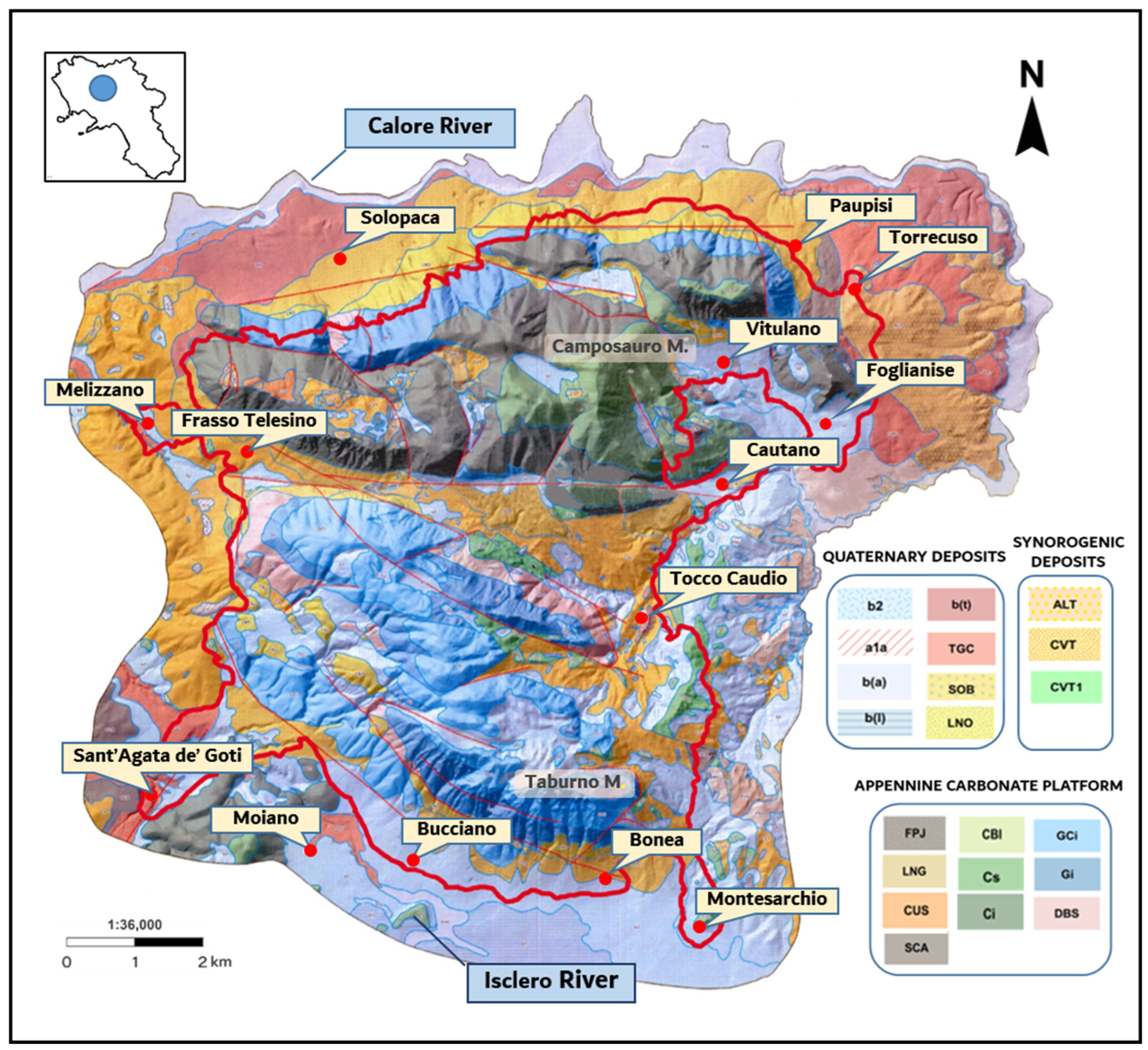
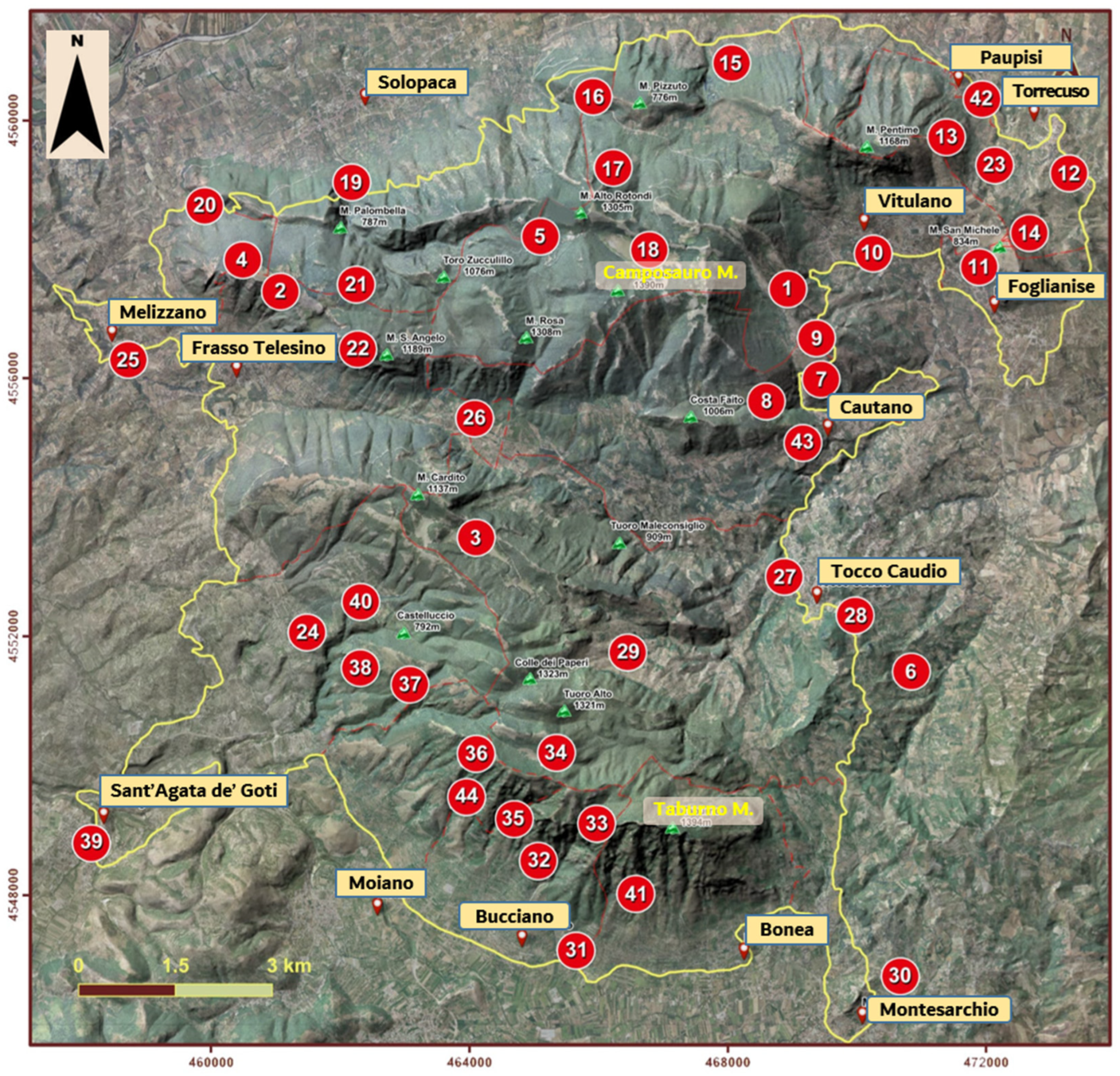
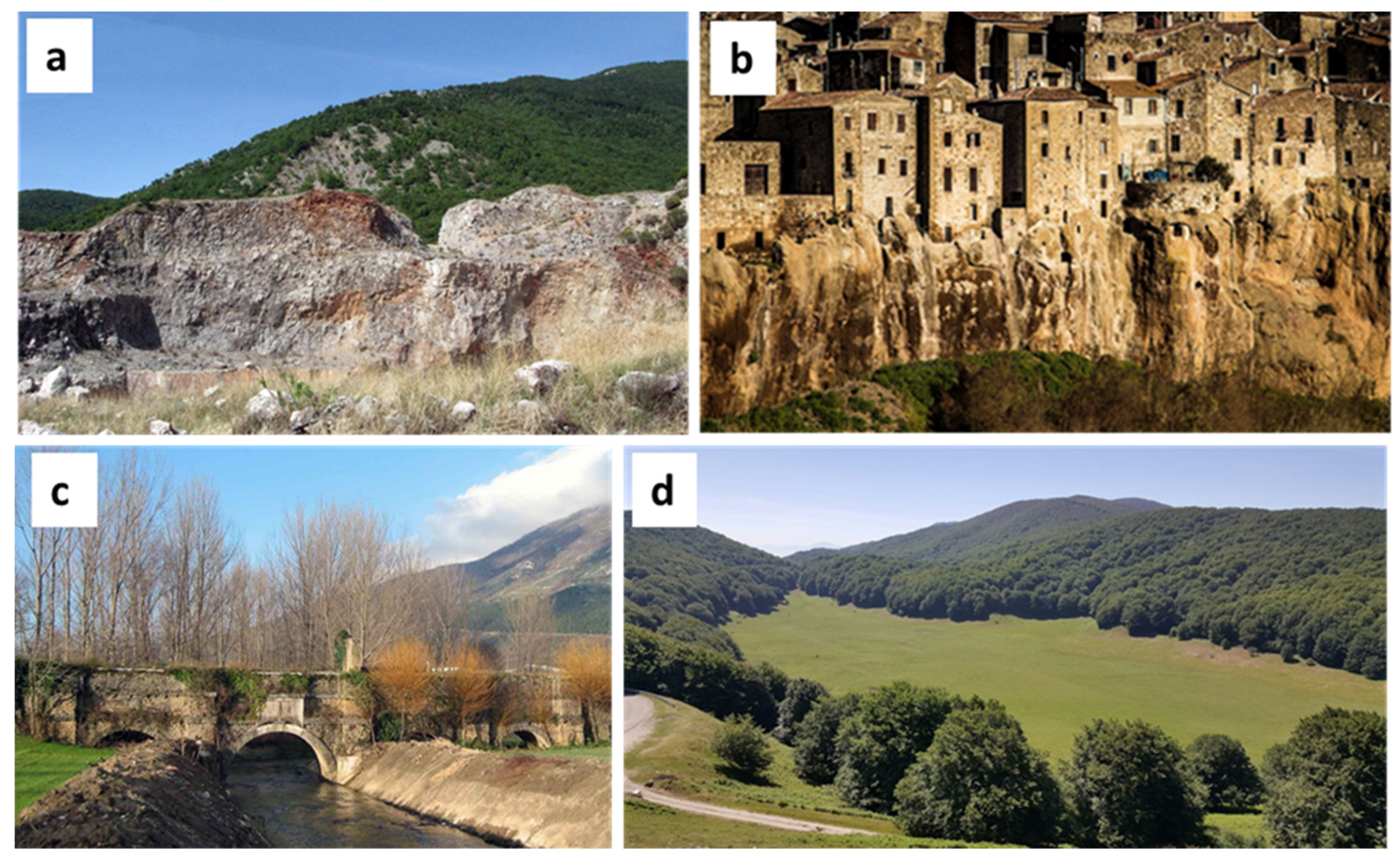
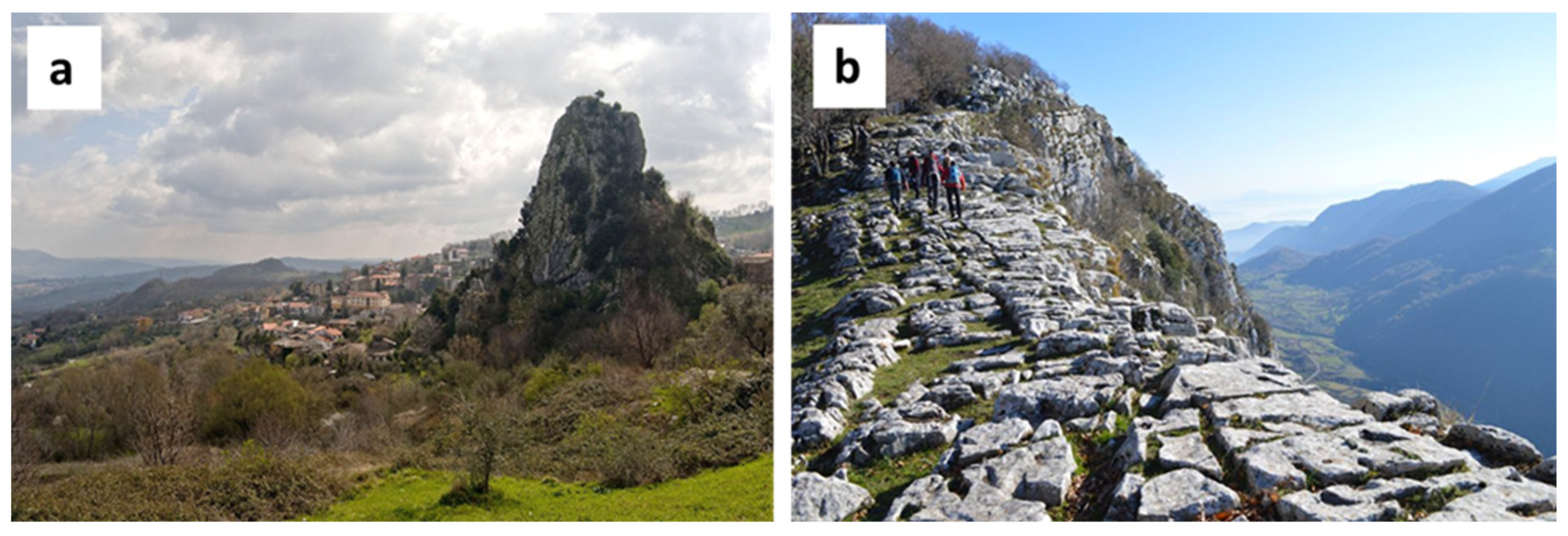

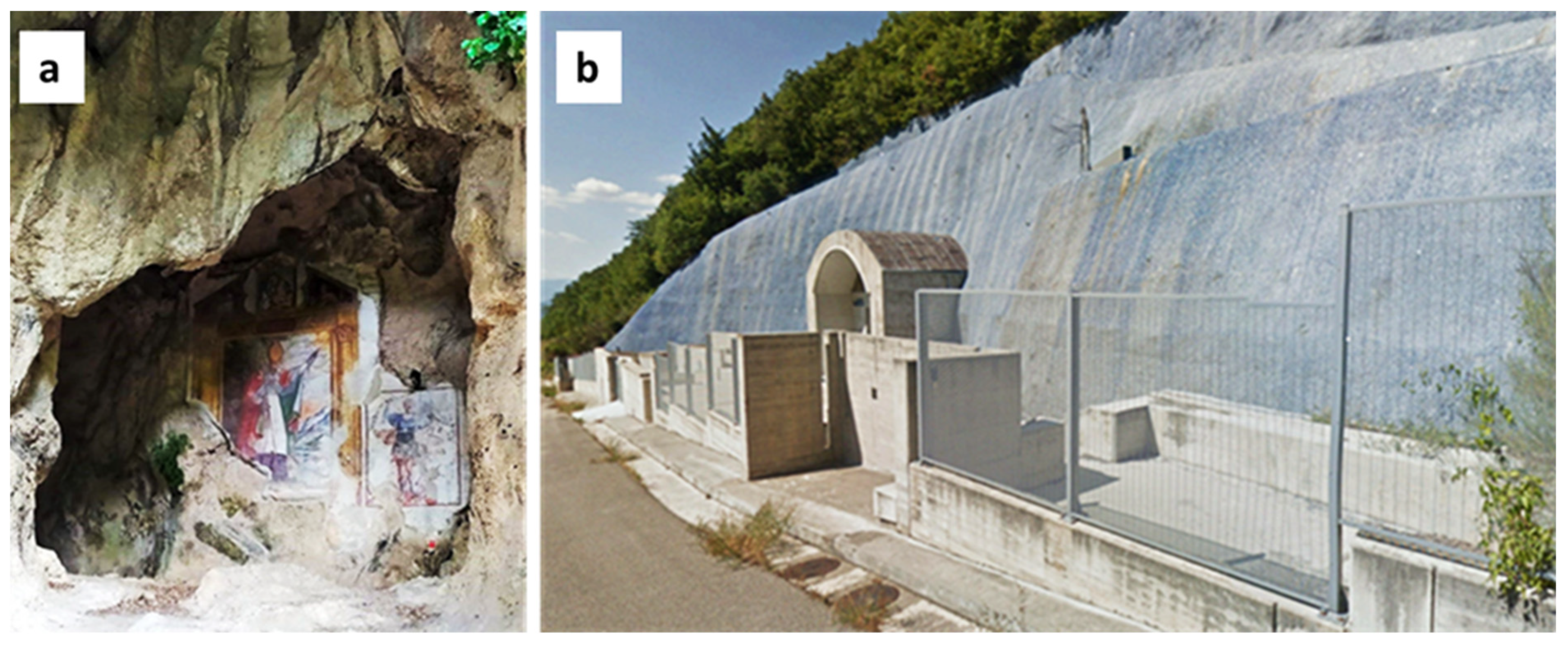
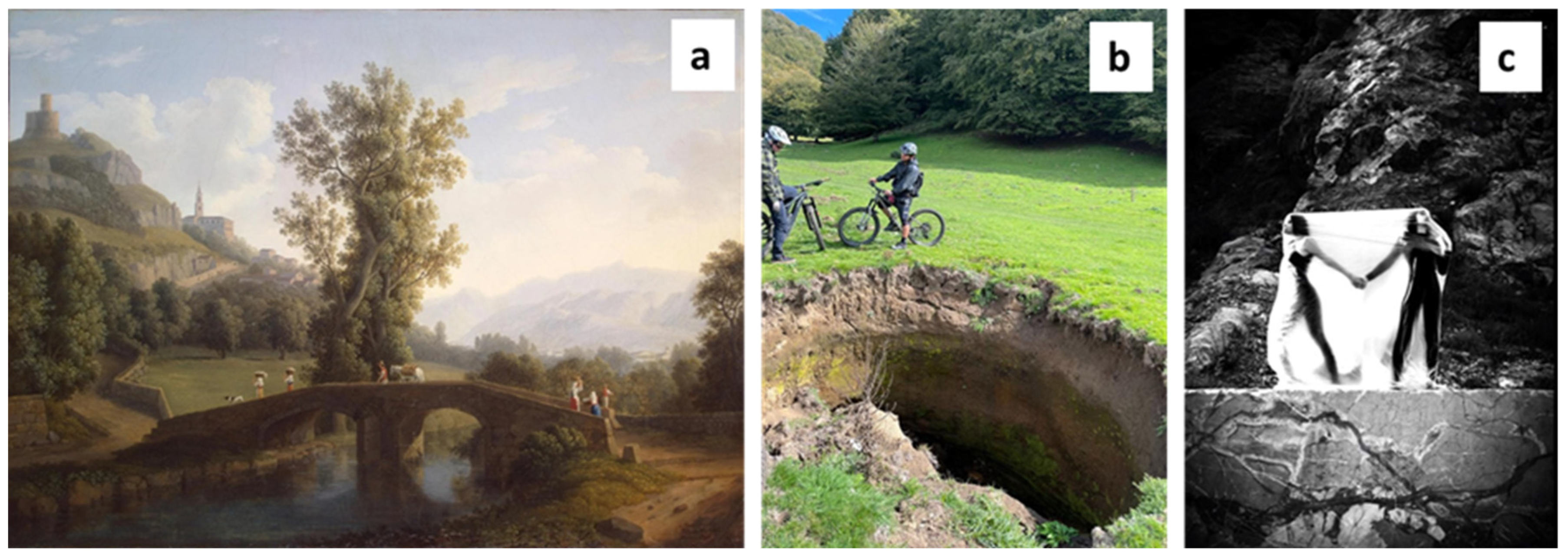
Disclaimer/Publisher’s Note: The statements, opinions and data contained in all publications are solely those of the individual author(s) and contributor(s) and not of MDPI and/or the editor(s). MDPI and/or the editor(s) disclaim responsibility for any injury to people or property resulting from any ideas, methods, instructions or products referred to in the content. |
© 2024 by the authors. Licensee MDPI, Basel, Switzerland. This article is an open access article distributed under the terms and conditions of the Creative Commons Attribution (CC BY) license (https://creativecommons.org/licenses/by/4.0/).
Share and Cite
Palazzo, P.; Valente, A. Promoting Geoheritage in the Aspiring Geopark of Taburno-Camposauro (Southern Apennines, Italy) with Innovative Tools. Geosciences 2024, 14, 317. https://doi.org/10.3390/geosciences14120317
Palazzo P, Valente A. Promoting Geoheritage in the Aspiring Geopark of Taburno-Camposauro (Southern Apennines, Italy) with Innovative Tools. Geosciences. 2024; 14(12):317. https://doi.org/10.3390/geosciences14120317
Chicago/Turabian StylePalazzo, Pietro, and Alessio Valente. 2024. "Promoting Geoheritage in the Aspiring Geopark of Taburno-Camposauro (Southern Apennines, Italy) with Innovative Tools" Geosciences 14, no. 12: 317. https://doi.org/10.3390/geosciences14120317
APA StylePalazzo, P., & Valente, A. (2024). Promoting Geoheritage in the Aspiring Geopark of Taburno-Camposauro (Southern Apennines, Italy) with Innovative Tools. Geosciences, 14(12), 317. https://doi.org/10.3390/geosciences14120317







